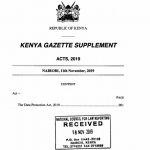How Safe are Children Online?
Including minority groups, persons below 18 years are the most vulnerable online. Children are often subjected to invasion of their privacy, bullying, grooming, child pornography, predators, harassment, solicitation and access to content meant for persons above 18 years. Children may also be creators of content harmful to themselves and others. Children do not possess legal power of consent to access certain information or engage in certain activities online. Hence, unless certain restrictions are made by parents, guardians, the law or online platforms children have access to almost any information accessible online.
Social media platforms provide for age restrictions for persons to access the platforms. FACEBOOK requires a person to be 13 years to create an account, the same age limit applies for popular social media platforms such as Instagram, Tik Tok and Twitter. The confirmation of age is pegged on the user’s ability to honestly provide their age which in most cases does not happen.
Social media flatforms have provision to protect children online. One may report an account if they know it is being run by a person below 13 years. Also, the platforms provide for reporting mechanisms for inappropriate/offensive content that may include breach of privacy, child pornography, cyberbullying, harassment, grooming or solicitation. The platforms often take down content that goes against their terms of use/community guidelines. In extreme cases, accounts are suspended or deactivated. Only challenge is that this does not prevent users from creating other pseudo accounts. Essentially the platforms play the role of the prosecutor, jury and judge in so far as their terms of use are concerned. In the absence of concrete legislation to regulate the safety of children online, the reporting mechanisms of these platforms are somewhat sufficient.
Platforms also offer guidelines for parents and guardians. Instagram published ‘KNOW HOW TO TALK WITH YOUR TEEN ABOUT INSTAGRAM: A PARENT’S GUIDE’. The guide has in-depth information on how to help teens manage privacy, interactions and time on Instagram.
Kenyan legislation is weak when it comes for protection of children online. The Computer Misuse and Cybercrimes Act has a few provisions that seek to protect children online. However, the Act is subject to a petition challenging its constitutionality; the courts are yet to render their verdict on certain provisions of the Act.
Notwithstanding with petition, some of the provisions attempt to offer a legal framework for protecting children online. Section 24 of the Computer Misuse and Cybercrimes Act makes it an offence to publish, produce, posses, download, distribute, transmit, disseminate, circulate, deliver, exhibit, lend for gain, exchange, barter, sell or offer for sale any form of child pornography. On the other hand, Section 27 outlaws cyber harassment. The two provisions are the insufficient in dealing with current and emerging cyber threats to children.
Article 53(1)(d) of the Constitution provides that every child has the right to be protected from abuse and all forms of violence. My interpretation of this provision is that children must also be protected from online harms. The Children Act that is meant to provide life to Article 53(1)(d) of the Constitution is outdated in terms of providing legal guidelines to protect children online. In as much as Section 4 of the Children Act provides for best interest of the child, this is insufficient to deal with online harms targeted at children. An overhaul of the Act is needed to be in line with contemporary challenges facing children.
The Communication Authority of Kenya in 2018 came up with an initiative dubbed ‘Be the Cop’ meant to provide online protection for children. The Authority published a booklet aimed at providing guidelines on online protection. The booklet offers definitions for certain online crimes targeted at children, it also defines internet addiction and provides online safety tips for children. Being a guide, the booklet has no enforcement mechanisms. The Authority however, established the Kenya Computer Incident Response Team Coordination Centre (KE-CIRT/CC) where one may report online abuse.
UNICEF in 2015 published ‘Guidelines for Industry on Child Online Protection’. The general guidelines that relate to internet service providers and mobile operators include integrating child rights considerations into all appropriate corporate policies and management processes; developing standard processes to handle child sexual abuse material; creating a safer and age appropriate online environment; and educating children, parents, and teachers about children’s safety and their responsible use of ICTs. Kenyan internet service providers and mobile operators are yet to integrate the UNICEF guidelines. In fact, such guidelines ought to be integrated into legislation.
The way forward for Kenya in protecting children online include –
One, amending the Children Act to include regulation of online harms for children. Two, having legislation that regulates online abuses while protecting fundamental rights and freedoms online. Such legislation would have reporting, take down and compensation mechanisms. Three, integrating child online protection into the education curriculum. Four, having internet platforms, internet service providers and mobile operators integrate child online protection into their operations. Five, having parents and guardians adopt a greater role in policing what content children access or generate online.
As we seek to implement the above, enforcement of community guidelines by online platforms continue to provide easy means to deal with child protection online.




